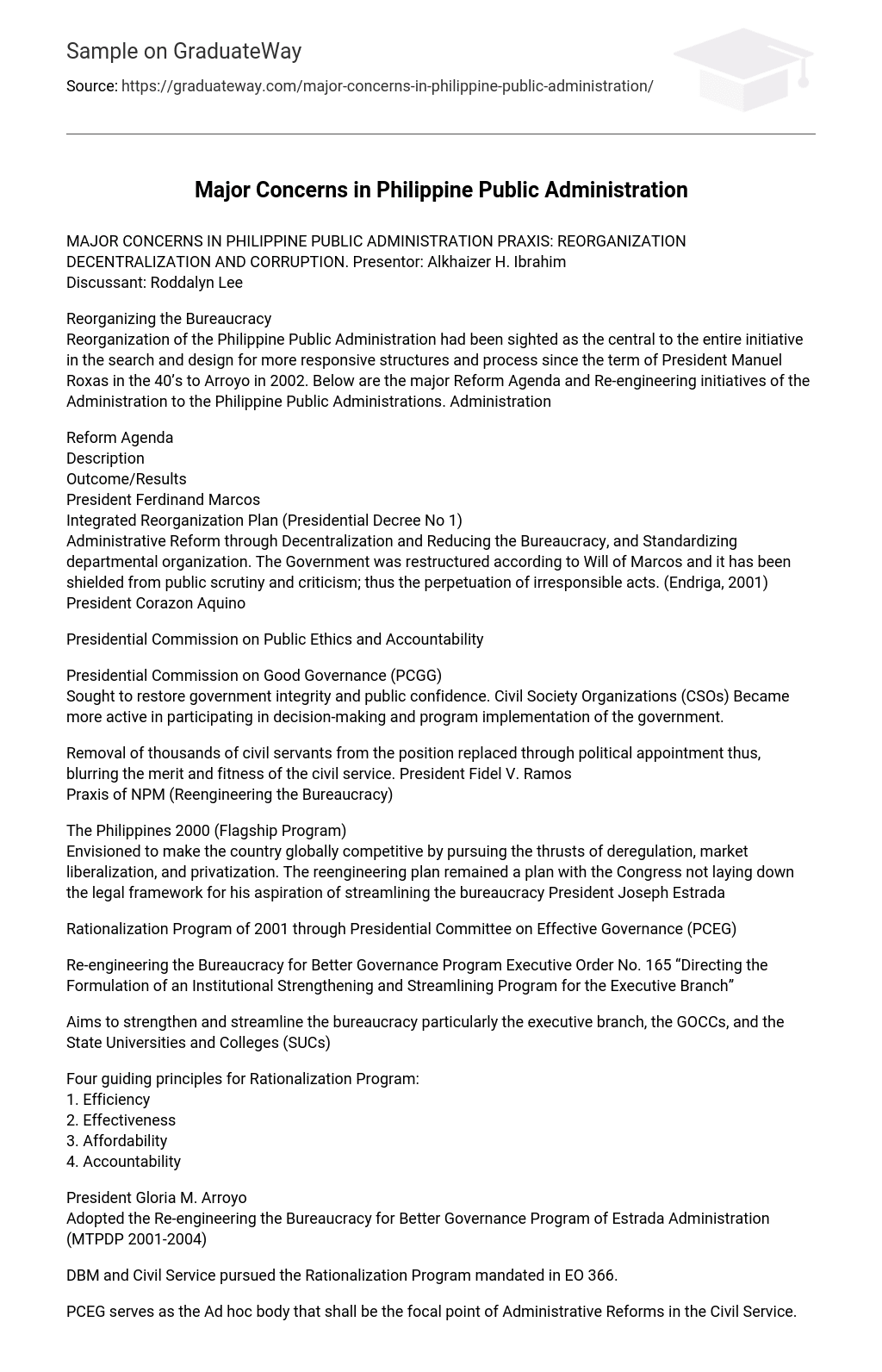The Arroyo administration is pursuing a two-track approach, the administrative and the legislative tracks. In 2003, the administration has already allocated 15 million pesos for early retirement, However, Congress failed to pass a reengineering law. As such, Pres. Arroyo has started her own rationalization law upon assumption into office in 2001. (Rama, 1999)
The EO No. 366 issued by President Gloria Macapagal Arroyo provides the strategic review of operations and organizations under the Executive Branch, and options and incentives for affected government employees. EO 366 directs all agencies under the Executive branch to submit a strategic review of operations of organizations and attached agencies.
The rationalization Plan then will be drafted based on the operations reviews. This Rationalization plan tackles structural reforms aimed to, among others, address shifts in policy directions of the agency, redundant or outdated functions, functions that have been devolved to LGUs, and functions that compete with the private sector.
However, according to the Article presented by Alex Brillantes Jr. and Maricel Fernandez on 2008 “After four years of the implementation of the EO 366, only 17 out of 26 department agencies of the government, 27 OEOs/Other government agencies, and only 36 out of more than 100 GOCCs in the country have submitted their rationalization plans. Out of the 80 submitted rational plans, only two department-level offices and nine GOCCs were approved; three departments have been evaluated but were not approved.
Out of the 44 plans (Complete and partial submission) that are under evaluation, eight departments and 19 GOCCs have completed their submission while three departments and four from the GOCCS have made partial submission. Moreover, there were plans returned for revision; one from the department and four from the GOCCs. DBM is expecting submissions from three departments and 24 GOCCs. Options for Affected Personnel
The cost containment measures focus mainly on reducing personnel size. In the process of reviewing agency operations and organizations, some functions/units may be found redundant, overlapping or duplicating with others. Thereby EO No. 366 offers the Voluntary Retirement Scheme. Under this scheme, agencies with redundant functions or those incurring revenue losses for the government are first identified. These employees then are given two options to remain in government service and be placed in other government agencies needing personnel or Avail of retirement/separation benefits, if qualified, plus the applicable incentives. (Brillantes Jr. and Fernandez, 2008)
According to Policy Insights of the Philippine Senate Economic Planning Office, “The early retirement package will give an average retirement benefit of close to Php 1 million per beneficiary and will be funded by the national government (Php 15 billion) through US$300-milllion World Bank loan. According to the Department of Budget and Management, the government will save some Php 7.7 billion yearly from the reduction in the wage bill thus recouping the Php15 billion loan in two years. The projected savings is anchored on the assumption that 30,000 employees will avail of the separation/retirement plan. It is interesting to note that the savings is a mere 2.6 percent of the annual allocation for personnel expenditure.
Hence, the fiscal impact is small and may not really address the inefficiency concerns of the bureaucracy.” According to the Data taken from DBM in 2008, as of April 2008, 2,170 regular positions (87% or 1,888 funded and 13% or 282 unfunded items) and 1,137 contractual/casual positions (86% of these or 978 contractual items and 14% or 159 casual items) have been abolished, which in effect, generated Php 422 Million (Php 379 Million explicit and Php 43Million implicit). These savings were plowed back to the concerned department agencies to beef up their funds for their purposes like maintenance and other operating expenses and capital outlay.
On the other hand, 1778 employees were affected by the Rationalization Program. 94% or 1,667 have opted to retire while 6% or 111 employees have opted to be place to other agencies such as DOH-managed hospitals, Dep-Ed supervised schools, BJMP, LTO, NSO and PNP. Benefits paid for those who retired amounted to Php 160 Million. (Brillantes Jr. and Fernandez, 2008) The Growth of the Philippine Bureaucracy
As of 2004, a total of 1, 475, 699 personnel were employed in NGAs, GOCCs, and LGUs. About 67.86% of the total number of the government agencies assigned to NGAs and only 25.9% of the total number of government workforce. The GOCCs registered the lowest complement at 7.04% of the total government workforce. As to the distribution of personnel by regions, NCR comprises the biggest pie with 26.63% of the total number of workforce from all subdivisions followed by regions 5 and 6 with 10.64% and 7.48% respectively.
CAR has the lowest complement with only 2.18 percent of the total number of employees. In terms of distribution of Employees from NGAs, 32% of 1,001,495 employees concentrated in NCR, 2.03 % from CAR, and 2.47 % from CARAGA. As for the GOCCs, NCR got the biggest slice with 67.61% and ARMM has the lowest number of personnel with a percentage of 0.18% or 103,977 employees.
In terms of the distribution of Employees in LGUs, Region 5 has 14.95% of 370, 227 total employees. NCR has 12.56% and ARMM again has the lowest LGU personnel with 2.24%. With the data presented earlier, it can be noted that there is really a misdistribution of employees where in most of them come from the National Government Agencies (NCR) and the only a few to the areas that needs more public services such as the ARMM.
REFERENCES
- 1. IS THERE A PHILIPPINE PUBLIC ADMINISTRATION? OR BETTER STILL, FOR WHOM IS THE PHILIPPINE PUBLIC ADMINISTRATION? – Alex Brillantes, Jr. and Maricel Fernandez
- REENGINEERING THE BUREAUCRACY: Issues and Problems. Policy Insights – Senate Economic Planning Office, April 2005
- THE AQUINO MANAGEMENT OF THE PRESIDENCY. Foundation for Policy Making – Presidential Management Staff, Office of the President, June 1992





